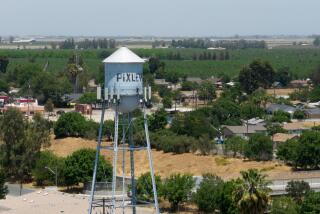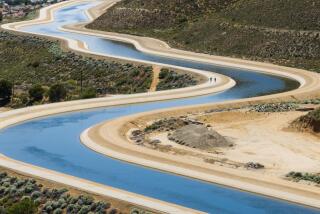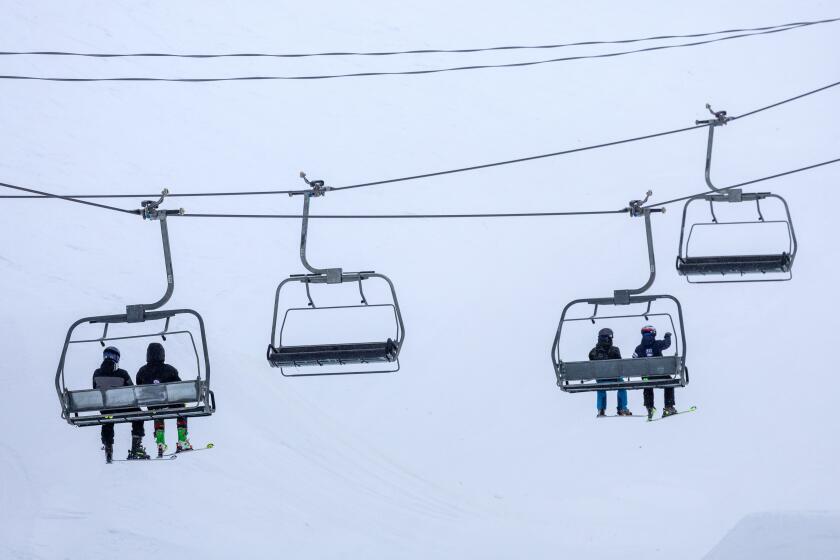Project Is Left Adrift by ‘Paper Water’
- Share via
In the latest court ruling that forces developers to prove a reliable water supply, a state appeals panel in Los Angeles has blocked construction of a large industrial park in Santa Clarita after finding the project relied on imported “paper water” that may not be delivered.
A three-justice panel of the 2nd District Court of Appeal ruled this week that Santa Clarita and the developer of a 4.2-million-square-foot industrial park counted on overly optimistic projections of how much water could be imported from northern snowpacks each year via the California Aqueduct.
The justices struck down the city’s approval of the project’s environmental report, partly because it “does not discuss the fact that [State Water Project] entitlements are ... only ‘paper’ water” that in dry years could be greatly reduced.
They returned the case to the trial court until a detailed analysis of reliable water supplies was provided.
“This is a big deal,” said Lynne Plambeck, president of the Santa Clarita Organization for Planning the Environment, which has helped force new water studies on three large projects since 2000, including the giant Newhall Ranch development. Other environmental groups have prevailed in a fourth Santa Clarita Valley case.
“For 30 or 40 years, we’ve been building houses in Southern California and expecting the water will come,” Plambeck said. “But these court decisions are saying that’s not good enough anymore.”
Attorney Stephen Onstot, who represented Santa Clarita, downplayed the appeals court decision.
“It’s a fix-it ticket,” Onstot said. “It’s a whole lot different than the appellate court saying, ‘Go back to square one.’ The court found only selected water-supply problems and said to have those problems fixed.”
The Santa Clarita Valley has become a key battleground in California’s water wars between environmental groups that oppose rapid urban expansion and the cities, counties, water agencies and developers who sign off on large new projects.
Environmentalists contend new projects rely on “paper water” -- the entitlements to supplies from the State Water Project. But these supplies are over-allocated even during wet years, they argue, and only a small fraction of supplies is available during drought. For example, some water agencies received only 20% of entitled state deliveries at the end of a long drought in the early 1990s.
The courts have increasingly sided with environmentalists in forcing more detailed analyses of water supplies before new projects can be built.
In Wednesday’s 49-page decision, the appellate justices found “insufficient evidence exists to support the [environmental report’s] conclusion that sufficient water supplies exist for the project.”
Specifically, they said the developer suggests Castaic Lake Water Agency’s 54,000 acre-foot annual state water entitlement is a reliable supply, when the agency would typically receive about half that amount, depending on snow and rain in the Northern Sierra range. An acre-foot of water meets the needs of two families for a year.
In addition, justices found unreliable the 41,000 acre-feet a year Castaic bought from a Kern County water agency in 1999.
That’s because the legality of such transfers is still under review, and a decision on the issue is not expected until next year.
“Plainly, there is no surplus upon which to rely, absent the 41,000 [acre-foot] transfer,” the justices found.
The justices noted that in a previous lawsuit, Dan Masnada, general manager of the Castaic Lake Water Agency, stated that if his agency hadn’t been able to use the Kern County water, the Santa Clarita Valley would have experienced water shortages in 2001 and 2002.
Masnada said Friday that the 41,000 acre-foot transfer was “a done deal. We have complied with a previous court decision on this issue, revised our EIR on the transfer, and we’re sure it’s going to stand up in court.”
He also said the justices were wrong in concluding that the State Water Project typically delivers only about half of entitlements. The state Department of Water Resources reports 77% reliability, he said. The transfer is being fought by environmental groups, he said, that are “less interested in protecting the environment than they are in imposing their land-use planning desires. It’s about restricting growth in our service area.”
The Castaic agency paid nearly $46 million for the Kern water six years ago. A year later the transfer of water began -- a portion is now used, some is being stored for dry years and some is slated for future growth, Masnada said.
The water supply issue is particularly hot in the fast-growing Santa Clarita Valley, because tens of thousands of new dwellings have already been approved for construction over the next 20 years, Plambeck said.
“I think we are an archetype for water problems throughout the state,” she said. “People feel that some of these violations are so egregious that if we get them addressed here, there will be overflow for the entire state.”
Onstot, the lawyer for Santa Clarita, said he is increasingly representing cities in water-supply disputes.
“This issue is becoming more and more prevalent as Southern California grows and there’s a greater demand for water,” he said. “But it has to be dealt with on a case-by-case basis. Every scenario is different.”
More to Read
Sign up for Essential California
The most important California stories and recommendations in your inbox every morning.
You may occasionally receive promotional content from the Los Angeles Times.










